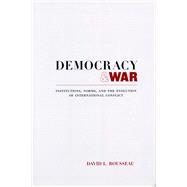
Note: Supplemental materials are not guaranteed with Rental or Used book purchases.
Purchase Benefits
What is included with this book?
| List of Tables and Figures | xiii | ||||
| Acknowledgments | xvii | ||||
| 1. Introduction: Domestic Institutions, Political Norms, and the Evolution of International Conflict | 1 | (17) | |||
|
4 | (7) | |||
|
11 | (2) | |||
|
13 | (1) | |||
|
14 | (1) | |||
|
15 | (3) | |||
| 2. The Impact of Institutions and Norms in International Crises | 18 | (82) | |||
|
20 | (7) | |||
|
27 | (2) | |||
|
29 | (19) | |||
|
34 | (4) | |||
|
38 | (5) | |||
|
43 | (5) | |||
|
48 | (31) | |||
|
49 | (17) | |||
|
51 | (2) | |||
|
53 | (3) | |||
|
56 | (1) | |||
|
57 | (1) | |||
|
58 | (1) | |||
|
59 | (1) | |||
|
60 | (1) | |||
|
61 | (1) | |||
|
62 | (1) | |||
|
63 | (3) | |||
|
66 | (50) | |||
|
67 | (1) | |||
|
68 | (11) | |||
|
79 | (1) | |||
|
79 | (1) | |||
|
80 | (3) | |||
|
83 | (6) | |||
|
89 | (2) | |||
|
91 | (1) | |||
|
92 | (8) | |||
| 3. International Disputes and the Evolution of Conflict | 100 | (39) | |||
|
103 | (2) | |||
|
105 | (11) | |||
|
116 | (13) | |||
|
117 | (4) | |||
|
121 | (8) | |||
|
129 | (1) | |||
|
130 | (3) | |||
|
133 | (1) | |||
|
133 | (6) | |||
| 4. Institutional Constraint Versus Regime Type | 139 | (62) | |||
|
140 | (17) | |||
|
145 | (3) | |||
|
148 | (3) | |||
|
151 | (6) | |||
|
157 | (34) | |||
|
158 | (8) | |||
|
158 | (2) | |||
|
160 | (2) | |||
|
162 | (1) | |||
|
163 | (3) | |||
|
166 | (8) | |||
|
167 | (3) | |||
|
170 | (2) | |||
|
172 | (1) | |||
|
173 | (1) | |||
|
173 | (1) | |||
|
174 | (8) | |||
|
175 | (4) | |||
|
179 | (3) | |||
|
182 | (37) | |||
|
183 | (4) | |||
|
187 | (4) | |||
|
191 | (2) | |||
|
193 | (1) | |||
|
194 | (7) | |||
| 5. Political Norms Versus Institutional Structures | 201 | (67) | |||
|
206 | (2) | |||
|
208 | (6) | |||
|
214 | (5) | |||
|
219 | (13) | |||
|
222 | (3) | |||
|
225 | (2) | |||
|
227 | (5) | |||
|
232 | (9) | |||
|
233 | (1) | |||
|
233 | (2) | |||
|
235 | (2) | |||
|
237 | (2) | |||
|
239 | (2) | |||
|
241 | (9) | |||
|
242 | (1) | |||
|
243 | (4) | |||
|
247 | (3) | |||
|
250 | (6) | |||
|
250 | (3) | |||
|
253 | (3) | |||
|
256 | (1) | |||
|
257 | (2) | |||
|
259 | (1) | |||
|
260 | (8) | |||
| 6. Democratization and International Conflict | 268 | (38) | |||
|
268 | (4) | |||
|
270 | (1) | |||
|
271 | (1) | |||
|
272 | (2) | |||
|
274 | (7) | |||
|
274 | (7) | |||
|
281 | (19) | |||
|
281 | (11) | |||
|
292 | (8) | |||
|
300 | (1) | |||
|
301 | (5) | |||
| 7. The Evolution of Conflicts, Institutions, and Norms: An Agent-Based Simulation | 306 | (33) | |||
|
307 | (2) | |||
|
309 | (17) | |||
|
314 | (1) | |||
|
314 | (1) | |||
|
315 | (4) | |||
|
315 | (3) | |||
|
318 | (1) | |||
|
318 | (1) | |||
|
319 | (2) | |||
|
321 | (5) | |||
|
326 | (2) | |||
|
328 | (9) | |||
|
337 | (2) | |||
| 8. Conclusions | 339 | (2) | |||
| Synthesizing Across Cases: The Breakdown of Structural and Normative Constraints | 341 | (6) | |||
| Future Research | 347 | (2) | |||
| Notes | 349 | (2) | |||
| Bibliography | 351 | (24) | |||
| Index | 375 |
The New copy of this book will include any supplemental materials advertised. Please check the title of the book to determine if it should include any access cards, study guides, lab manuals, CDs, etc.
The Used, Rental and eBook copies of this book are not guaranteed to include any supplemental materials. Typically, only the book itself is included. This is true even if the title states it includes any access cards, study guides, lab manuals, CDs, etc.